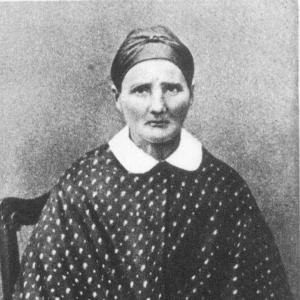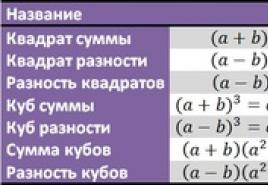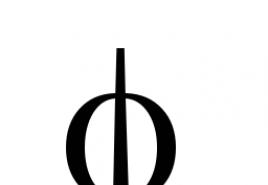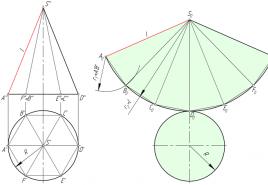Brief multiplication formulas. Abbreviated Multiplication Formulas - Knowledge Hypermarket
One of the first topics studied in the algebra course is abbreviated multiplication formulas. In grade 7, they are used in the simplest situations where you need to recognize one of the formulas in an expression and perform a factorization of a polynomial, or, conversely, quickly raise the sum or difference to a square or cube. In the future, the FSU is used to quickly solve inequalities and equations, and even to calculate some numerical expressions without a calculator.
What a list of formulas looks like
There are 7 basic formulas that allow you to quickly multiply the polynomials in parentheses.
Sometimes this list also includes an expansion for the fourth degree, which follows from the presented identities and has the form:
a⁴ - b⁴ = (a - b) (a + b) (a² + b²).
All equalities have a pair (sum - difference), except for the difference of squares. For the sum of squares, the formula is not given.
The rest of the equalities are easy to remember.:

It should be remembered that FSOs work in any case and for any values a and b: it can be either arbitrary numbers or whole expressions.
In a situation, if you suddenly cannot remember what sign is in the formula in front of one or another term, you can open the brackets and get the same result as after using the formula. For example, if a problem arose when applying the FSO of the cube of the difference, you need to write down the original expression and perform the multiplication in turn:
(a - b) ³ = (a - b) (a - b) (a - b) = (a² - ab - ab + b²) (a - b) = a³ - a²b - a²b + ab² - a²b + ab² + ab² - b³ = a³ - 3a²b + 3ab² - b³.
As a result, after reducing all similar terms, the same polynomial was obtained as in the table. The same manipulations can be carried out with all other FSOs.

Application of FSO for solving equations
For example, you need to solve an equation containing polynomial of degree 3:
x³ + 3x² + 3x + 1 = 0.
The school curriculum does not consider universal techniques for solving cubic equations, and such tasks are most often solved by simpler methods (for example, factorization). If you notice that the left side of the identity resembles a cube of a sum, then the equation can be written in a simpler form:
(x + 1) ³ = 0.
The root of such an equation is calculated orally: x = -1.
Inequalities are solved in a similar way. For example, we can solve the inequality x³ - 6x² + 9x> 0.

The first step is to factor the expression. First you need to take out the brackets x... After that, you should note that the expression in parentheses can be converted to the square of the difference.
Then you need to find the points at which the expression takes zero values, and mark them on the number line. In a specific case, these will be 0 and 3. Then, using the interval method, determine in which intervals x will correspond to the inequality condition.
FSOs can be useful when performing some calculations without the help of a calculator:
703² - 203² = (703 + 203) (703 - 203) = 906 ∙ 500 = 453000.
In addition, by factoring expressions, you can easily perform fraction cancellation and simplification of various algebraic expressions.
Examples of tasks for grades 7-8
In conclusion, we will analyze and solve two problems on the application of formulas for abbreviated multiplication in algebra.
Task 1. Simplify the expression:
(m + 3) ² + (3m + 1) (3m - 1) - 2m (5m + 3).
Solution. In the condition of the task, it is required to simplify the expression, that is, to open the brackets, perform the operations of multiplication and exponentiation, and also bring all such terms. Let us conditionally divide the expression into three parts (according to the number of terms) and open the brackets one by one, applying the FSO where possible.
- (m + 3) ² = m² + 6m + 9(the square of the sum);
- (3m + 1) (3m - 1) = 9m² - 1(difference of squares);
- In the last term, multiplication must be performed: 2m (5m + 3) = 10m² + 6m.

Let's substitute the obtained results into the original expression:
(m² + 6m + 9) + (9m² - 1) - (10m² + 6m).
Taking into account the signs, we will open the brackets and give similar terms:
m² + 6m + 9 + 9m² 1 - 10m² - 6m = 8.
Problem 2. Solve the equation containing the unknown k to the 5th power:
k⁵ + 4k⁴ + 4k³ - 4k² - 4k = k³.
Solution. In this case, it is necessary to use the FSO and the grouping method. It is necessary to transfer the last and penultimate term to the right-hand side of the identity.
k⁵ + 4k⁴ + 4k³ = k³ + 4k² + 4k.
The common factor is taken out from the right and left sides (k² + 4k +4):
k³ (k² + 4k + 4) = k (k² + 4k + 4).
Everything is transferred to the left side of the equation so that 0 remains on the right:
k³ (k² + 4k + 4) - k (k² + 4k + 4) = 0.
Again, you need to take out the common factor:
(k³ - k) (k² + 4k + 4) = 0.
From the first obtained factor, you can take k... According to the formula for short multiplication, the second factor will be identically equal to (k + 2) ²:
k (k² - 1) (k + 2) ² = 0.
Using the difference of squares formula:
k (k - 1) (k + 1) (k + 2) ² = 0.
Since the product is equal to 0, if at least one of its factors is zero, it will not be difficult to find all the roots of the equation:
- k = 0;
- k - 1 = 0; k = 1;
- k + 1 = 0; k = -1;
- (k + 2) ² = 0; k = -2.
Based on illustrative examples, you can understand how to remember the formulas, their differences, and also solve several practical problems using the FSU. The tasks are simple, and there should be no difficulty in completing them.
Abbreviated Multiplication Formulas (ACF) are used for exponentiation and multiplication of numbers and expressions. Often these formulas allow you to make calculations more compact and faster.
In this article, we will list the basic formulas for abbreviated multiplication, group them in a table, consider examples of using these formulas, and also dwell on the principles of proof of abbreviated multiplication formulas.
For the first time, the topic of FSU is considered within the framework of the "Algebra" course for the 7th grade. Below are 7 basic formulas.
Abbreviated multiplication formulas
- the formula for the square of the sum: a + b 2 = a 2 + 2 a b + b 2
- the formula for the square of the difference: a - b 2 = a 2 - 2 a b + b 2
- sum cube formula: a + b 3 = a 3 + 3 a 2 b + 3 a b 2 + b 3
- difference cube formula: a - b 3 = a 3 - 3 a 2 b + 3 a b 2 - b 3
- difference of squares formula: a 2 - b 2 = a - b a + b
- the formula for the sum of cubes: a 3 + b 3 = a + b a 2 - a b + b 2
- the formula for the difference of cubes: a 3 - b 3 = a - b a 2 + a b + b 2
The letters a, b, c in these expressions can be any numbers, variables or expressions. For ease of use, it is best to learn the seven basic formulas by heart. Let's summarize them in a table and present them below, encircling them with a frame.
The first four formulas allow you to calculate, respectively, the square or cube of the sum or difference of two expressions.
The fifth formula calculates the difference of the squares of the expressions by the product of their sum and the difference.
The sixth and seventh formulas are, respectively, the multiplication of the sum and difference of expressions by an incomplete square of the difference and an incomplete square of the sum.
The abbreviated multiplication formula is sometimes also called the abbreviated multiplication identities. This is not surprising, since every equality is an identity.
When solving practical examples, abbreviated multiplication formulas with rearranged left and right sides are often used. This is especially useful when a factorization of a polynomial takes place.

Additional abbreviated multiplication formulas
We will not limit ourselves to the 7th grade course in algebra and add a few more formulas to our FSU table.
First, consider the Newton binomial formula.
a + b n = C n 0 a n + C n 1 a n - 1 b + C n 2 a n - 2 b 2 +. ... + C n n - 1 a b n - 1 + C n n b n
Here C n k are binomial coefficients that are in row n in the pascal triangle. Binomial coefficients are calculated by the formula:
C n k = n! k! (N - k)! = n (n - 1) (n - 2). ... (n - (k - 1)) k!
As you can see, the FSE for the square and the cube of the difference and the sum is a special case of the Newton binomial formula for n = 2 and n = 3, respectively.
But what if there are more than two terms in the sum to be raised to the power? The formula for the square of the sum of three, four or more terms will be useful.
a 1 + a 2 +. ... + a n 2 = a 1 2 + a 2 2 +. ... + a n 2 + 2 a 1 a 2 + 2 a 1 a 3 +. ... + 2 a 1 a n + 2 a 2 a 3 + 2 a 2 a 4 +. ... + 2 a 2 a n + 2 a n - 1 a n
Another formula that may come in handy is the formula for the difference between the n-th powers of two terms.
a n - b n = a - b a n - 1 + a n - 2 b + a n - 3 b 2 +. ... + a 2 b n - 2 + b n - 1
This formula is usually divided into two formulas - for even and odd degrees, respectively.
For even indicators 2m:
a 2 m - b 2 m = a 2 - b 2 a 2 m - 2 + a 2 m - 4 b 2 + a 2 m - 6 b 4 +. ... + b 2 m - 2
For odd exponents 2m + 1:
a 2 m + 1 - b 2 m + 1 = a 2 - b 2 a 2 m + a 2 m - 1 b + a 2 m - 2 b 2 +. ... + b 2 m
The formulas for the difference of squares and the difference of cubes, you guessed it, are special cases of this formula for n = 2 and n = 3, respectively. For the difference of cubes, b is also replaced with - b.
How to read abbreviated multiplication formulas?
We will give the appropriate formulations for each formula, but first we will understand the principle of reading formulas. The most convenient way to do this is by example. Let's take the very first formula for the square of the sum of two numbers.
a + b 2 = a 2 + 2 a b + b 2.
They say: the square of the sum of two expressions a and b is equal to the sum of the square of the first expression, the doubled product of the expressions and the square of the second expression.
All other formulas are read in the same way. For the square of the difference a - b 2 = a 2 - 2 a b + b 2 we write:
the square of the difference between the two expressions a and b is equal to the sum of the squares of these expressions minus twice the product of the first and second expressions.
Read the formula a + b 3 = a 3 + 3 a 2 b + 3 a b 2 + b 3. The cube of the sum of two expressions a and b is equal to the sum of the cubes of these expressions, three times the square of the first expression by the second, and three times the square of the second expression by the first expression.
We proceed to reading the formula for the difference between cubes a - b 3 = a 3 - 3 a 2 b + 3 a b 2 - b 3. The cube of the difference of two expressions a and b is equal to the cube of the first expression minus three times the square of the first expression and the second, plus three times the square of the second expression and the first expression, minus the cube of the second expression.
The fifth formula a 2 - b 2 = a - b a + b (difference of squares) reads as follows: the difference of the squares of two expressions is equal to the product of the difference and the sum of the two expressions.
Expressions like a 2 + a b + b 2 and a 2 - a b + b 2 for convenience are called, respectively, the incomplete square of the sum and the incomplete square of the difference.
With this in mind, the formulas for the sum and difference of the cubes will read as follows:
The sum of the cubes of two expressions is equal to the product of the sum of these expressions by the incomplete square of their difference.
The difference between the cubes of two expressions is equal to the product of the difference between these expressions and the incomplete square of their sum.
Proof of FSO
It is quite easy to prove the FSO. Based on the properties of multiplication, we multiply the parts of the formulas in parentheses.
For example, consider the formula for the square of the difference.
a - b 2 = a 2 - 2 a b + b 2.
To raise an expression to the second power, you need to multiply this expression by itself.
a - b 2 = a - b a - b.
Let's expand the brackets:
a - b a - b = a 2 - a b - b a + b 2 = a 2 - 2 a b + b 2.
The formula is proven. The rest of the FSOs are proved in a similar way.
Examples of FSU application
The purpose of using abbreviated multiplication formulas is to multiply and exponentiate expressions quickly and concisely. However, this is not the entire scope of the FSO. They are widely used in abbreviating expressions, reducing fractions, factoring polynomials. Here are some examples.
Example 1. FSO
Simplify the expression 9 y - (1 + 3 y) 2.
We apply the formula for the sum of squares and get:
9 y - (1 + 3 y) 2 = 9 y - (1 + 6 y + 9 y 2) = 9 y - 1 - 6 y - 9 y 2 = 3 y - 1 - 9 y 2
Example 2. FSO
Reduce the fraction 8 x 3 - z 6 4 x 2 - z 4.
Note that the expression in the numerator is the difference between the cubes, and the denominator is the difference in the squares.
8 x 3 - z 6 4 x 2 - z 4 = 2 x - z (4 x 2 + 2 x z + z 4) 2 x - z 2 x + z.
We shorten and get:
8 x 3 - z 6 4 x 2 - z 4 = (4 x 2 + 2 x z + z 4) 2 x + z
FSOs also help to calculate the values of expressions. The main thing is to be able to notice where to apply the formula. Let's show this with an example.
Let's square the number 79. Instead of cumbersome calculations, we write:
79 = 80 - 1 ; 79 2 = 80 - 1 2 = 6400 - 160 + 1 = 6241 .
It would seem that a complex calculation was carried out quickly with just using the abbreviated multiplication formulas and the multiplication table.
Another important point is the selection of the square of the binomial. The expression 4 x 2 + 4 x - 3 can be converted to 2 x 2 + 2 · 2 · x · 1 + 1 2 - 4 = 2 x + 1 2 - 4. Such transformations are widely used in integration.
If you notice an error in the text, please select it and press Ctrl + Enter
When calculating algebraic polynomials, to simplify calculations, use abbreviated multiplication formulas... There are seven such formulas in total. You need to know all of them by heart.
It should also be remembered that instead of "a" and "b", formulas can contain both numbers and any other algebraic polynomials.
Difference of squares
Remember!
Difference of squares two numbers is equal to the product of the difference between these numbers and their sum.
a 2 - b 2 = (a - b) (a + b)- 15 2 - 2 2 = (15 - 2) (15 + 2) = 13 17 = 221
- 9a 2 - 4b 2 c 2 = (3a - 2bc) (3a + 2bc)
Sum squared
Remember!
The square of the sum of two numbers is equal to the square of the first number plus twice the product of the first number by the second plus the square of the second number.
(a + b) 2 = a 2 + 2ab + b 2
Note that with this shorthand multiplication formula, it's easy to find squares of large numbers without using a calculator or long multiplication. Let us explain with an example:
Find 112 2.
- Let us decompose 112 into the sum of the numbers whose squares we remember well.
112 = 100 + 1 - Let's write the sum of the numbers in brackets and put a square above the brackets.
112 2 = (100 + 12) 2 - Let's use the formula for the square of the sum:
112 2 = (100 + 12) 2 = 100 2 + 2 100 12 + 12 2 = 10 000 + 2 400 + 144 = 12 544
Remember that the squared sum formula is also valid for any algebraic polynomial.
- (8a + c) 2 = 64a 2 + 16ac + c 2
Warning!
(a + b) 2 is not equal to (a 2 + b 2)Difference squared
Remember!
The square of the difference between two numbers is equal to the square of the first number minus twice the product of the first number by the second plus the square of the second number.
(a - b) 2 = a 2 - 2ab + b 2
It's also worth remembering a very useful transformation:
(a - b) 2 = (b - a) 2The formula above is proved by simply expanding the parentheses:
(a - b) 2 = a 2 −2ab + b 2 = b 2 - 2ab + a 2 = (b - a) 2Sum cube
Remember!
The cube of the sum of two numbers is equal to the cube of the first number plus three times the square of the first number and the second plus three times the square of the second plus the cube of the second.
(a + b) 3 = a 3 + 3a 2 b + 3ab 2 + b 3
How to remember the sum cube
Remembering this "scary"-looking formula is quite simple.
- Learn to start with "a 3".
- The two polynomials in the middle have coefficients of 3.
- Recall that any number to the zero degree is 1. (a 0 = 1, b 0 = 1). It is easy to see that in the formula there is a decrease in the degree "a" and an increase in the degree "b". You can be convinced of this:
(a + b) 3 = a 3 b 0 + 3a 2 b 1 + 3a 1 b 2 + b 3 a 0 = a 3 + 3a 2 b + 3ab 2 + b 3
Warning!
(a + b) 3 is not equal to a 3 + b 3Difference cube
Remember!
Difference cube of two numbers is equal to the cube of the first number minus three times the square of the first number and the second plus three times the product of the first number and the square of the second minus the cube of the second.
(a - b) 3 = a 3 - 3a 2 b + 3ab 2 - b 3
This formula is remembered like the previous one, but only taking into account the alternation of the signs "+" and "-". The first term "a 3" is preceded by "+" (we do not write it according to the rules of mathematics). This means that the next member will be preceded by "-", then again "+", and so on.
(a - b) 3 = + a 3 - 3a 2 b + 3ab 2 - b 3 = a 3 - 3a 2 b + 3ab 2 - b 3Sum of cubes
Not to be confused with the sum cube!
Remember!
Sum of cubes is equal to the product of the sum of two numbers by the incomplete square of the difference.
a 3 + b 3 = (a + b) (a 2 - ab + b 2)The sum of cubes is the product of two parentheses.
- The first parenthesis is the sum of two numbers.
- The second bracket is an incomplete square of the difference of numbers. The expression is called an incomplete square of the difference:
(a 2 - ab + b 2)
This square is incomplete, since in the middle, instead of the doubled product, there is the usual product of numbers.
Difference of cubes
Not to be confused with the difference cube!
Remember!
Difference of cubes is equal to the product of the difference of two numbers by the incomplete square of the sum.
a 3 - b 3 = (a - b) (a 2 + ab + b 2)Be careful when writing characters.
Applying abbreviated multiplication formulas
It should be remembered that all the formulas given above are also used from right to left.
Many of the examples in the tutorials are designed to help you get the polynomial back together using formulas.
- a 2 + 2a + 1 = (a + 1) 2
- (ac - 4b) (ac + 4b) = a 2 c 2 - 16b 2
You can download a table with all the formulas for abbreviated multiplication in the section “
Multiplying a polynomial by a polynomial
! To multiply a polynomial by a polynomial, you need to multiply each term of one polynomial by each term of another polynomial and add the resulting products.
Be careful! Each term has its own sign.
Abbreviated multiplication formulas polynomials - this is, as a rule, 7 (seven) frequently occurring cases of multiplication of polynomials.
Definitions andAbbreviated multiplication formulas. table
Table 2. Definitions of abbreviated multiplication formulas (click to enlarge)
Three abbreviated multiplication formulas for squares
1. The formula for the square of the sum.
Sum squared two expressions is equal to the square of the first expression plus twice the product of the first expression by the second plus the square of the second expression.
To better understand the formula, let's first simplify the expression (expand the formula for the square of the sum)

Now let's factorize (we will collapse the formula)

The sequence of actions for factoring:
- determine which monomials were squared ( 5 and 3m);
- check if the doubled product is in the middle of the formula (2 5 3m = 30m);
- write down the answer (5 + 3m) 2.
2. Difference square formula
Difference squared two expressions is equal to the square of the first expression minus twice the product of the first expression by the second plus the square of the second expression.
First, let's simplify the expression (expand the formula):

And then, on the contrary, let us factorize (we will collapse the formula):

3. Difference of squares formula
The product of the sum of two expressions by their difference is equal to the difference of the squares of these expressions.
Collapse the formula (do the multiplication)
Now let's expand the formula (factorize)

Four abbreviated multiplication formulas for cubes
4. Cube formula of the sum of two numbers
The cube of the sum of two expressions is equal to the cube of the first expression plus three times the square of the first expression and the second plus three times the square of the second plus the cube of the second expression.

The sequence of actions when "folding" the formula:
- find monomials that were raised to a cube (here 4x and 1 );
- check the average terms for compliance with the formula;
- write down the answer.
5. Cube formula of difference of two numbers
The cube of the difference between the two expressions is equal to the cube of the first expression minus three times the square of the first expression and the second plus three times the product of the first expression and the square of the second minus the cube of the second expression.

6. The formula for the sum of cubes
The sum of the cubes of two expressions is equal to the product of the sum of the first and second expressions by the incomplete square of the difference between these expressions.

And back:

7. Cube Difference Formula
The difference between the cubes of two expressions is equal to the product of the difference between the first and second expressions by the incomplete square of the sum of these expressions.

Applying abbreviated multiplication formulas. table
An example of using formulas in practice (oral counting).
Task: Find the area of a square with side a = 71 cm.
Solution: S = a 2. Using the formula for the square of the sum, we have
71 2 = (70 + 1) 2 = 70 2 + 2 * 70 * 1 + 1 2 = 4900 + 140 + 1 = 5041 cm 2
Answer: 5041 cm 2
Expression ( a + b) 2 is the square of the sum numbers a and b... By definition of the degree, the expression ( a + ba + b)(a + b). Therefore, from the square of the sum, we can conclude that
(a + b) 2 = (a + b)(a + b) = a 2 + ab + ab + b 2 = a 2 + 2ab + b 2 ,
that is, the square of the sum of two numbers is equal to the square of the first number, plus twice the product of the first number by the second, plus the square of the second number.
sum square formula
(a + b) 2 = a 2 + 2ab + b 2
Polynomial a 2 + 2ab + b 2 is called the decomposition of the square of the sum.
Because a and b denote any numbers or expressions, then the rule gives us the ability, in an abbreviated way, to square any expression that can be considered as the sum of two terms.
Example. Square expression 3 x 2 + 2xy.
Solution: in order not to make additional transformations, we use the formula for the square of the sum. We should get the sum of the square of the first number, twice the product of the first number by the second, and the square of the second number:
(3x 2 + 2xy) 2 = (3x 2) 2 + 2(3x 2 2 xy) + (2xy) 2
Now, using the rules of multiplication and exponentiation of monomials, we simplify the resulting expression:
(3x 2) 2 + 2(3x 2 2 xy) + (2xy) 2 = 9x 4 + 12x 3 y + 4x 2 y 2
Difference squared
Expression ( a - b) 2 is squared difference numbers a and b... Expression ( a - b) 2 is the product of two polynomials ( a - b)(a - b). Therefore, from the squared difference, we can conclude that
(a - b) 2 = (a - b)(a - b) = a 2 - ab - ab + b 2 = a 2 - 2ab + b 2 ,
that is, the square of the difference between two numbers is equal to the square of the first number, minus twice the product of the first number by the second, plus the square of the second number.
It follows from the rule that the general squared difference formula, without intermediate transformations, will look like this:
(a - b) 2 = a 2 - 2ab + b 2
Polynomial a 2 - 2ab + b 2 is called the decomposition of the squared difference.
This rule applies to abbreviated squaring of expressions that can be represented as the difference of two numbers.
Example. Imagine the square of the difference as a three-term:
(2a 2 - 5ab 2) 2
Solution: using the formula for the square of the difference, we find:
(2a 2 - 5ab 2) 2 = (2a 2) 2 - 2(2a 2 5 ab 2) + (5ab 2) 2
Now let's convert the expression to a standard polynomial:
(2a 2) 2 - 2(2a 2 5 ab 2) + (5ab 2) 2 = 4a 4 - 20a 3 b 2 + 25a 2 b 4
Difference of squares
Expression a 2 - b 2 is difference of squares numbers a and b... Expression a 2 - b 2 is an abbreviated way of multiplying the sum of two numbers by their difference:
(a + b)(a - b) = a 2 + ab - ab - b 2 = a 2 - b 2 ,
that is, the product of the sum of two numbers by their difference is equal to the difference of the squares of these numbers.
It follows from the rule that the general difference of squares formula looks like that:
a 2 - b 2 = (a + b)(a - b)
This rule applies to abbreviated multiplication of expressions that can be represented: one as the sum of two numbers, and the other as the difference of the same numbers.
Example. Convert the work to a binomial:
(5a 2 + 3)(5a 2 - 3)
Solution:
(5a 2 + 3)(5a 2 - 3) = (5a 2) 2 - 3 2 = 25a 4 - 9
In the example, we applied the formula for the difference of squares from right to left, that is, we were given the right side of the formula, and we converted it to the left:
(a + b)(a - b) = a 2 - b 2
In practice, all three formulas considered are applied both from left to right and from right to left, depending on the situation.







